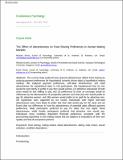The effect of attractiveness on food sharing preferences in human mating markets.
Abstract
The current study explored how physical attractiveness affects food sharing by studying payment preferences for hypothetical romantic dinner dates (a hypothetical mating market). We analyzed payment preferences, self-rated attractiveness, and rated attractiveness for hypothetical dates in 416 participants. We hypothesized that (1) men would be more likely to prefer to pay than would women, (2) attractive individuals of both sexes would be less willing to pay, and (3) preferences to enter an exchange would be influenced by the attractiveness of prospective partners such that (3a) men would prefer to pay for attractive women, and (3b) women would prefer to be paid for by attractive men. All hypotheses were supported by our results. Individuals with higher self-rated attractiveness were more likely to prefer that their date would pay for the meal, and we found clear sex differences in how the attractiveness of potential dates affected payment preferences. Male participants preferred to pay for dates that had higher facial attractiveness, while female participants preferred that attractive men would pay. Individuals show condition dependent financial preferences consistent with the provisioning hypothesis in this mating market that are adaptive to evaluations of their own quality and that of prospective partners.
Citation
Stirrat , M R , Gumert , M & Perrett , D I 2011 , ' The effect of attractiveness on food sharing preferences in human mating markets. ' , Evolutionary Psychology , vol. 9 , no. 1 , pp. 79-91 . https://doi.org/10.1177/147470491100900110
Publication
Evolutionary Psychology
Status
Peer reviewed
ISSN
1474-7049Type
Journal article
Description
This research was funded by an EPSRC grant received by the first author.Collections
Items in the St Andrews Research Repository are protected by copyright, with all rights reserved, unless otherwise indicated.

